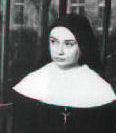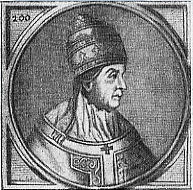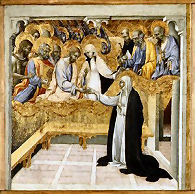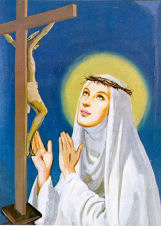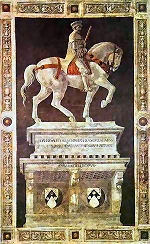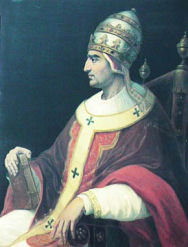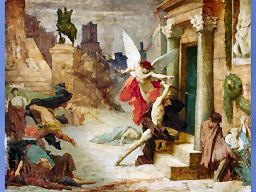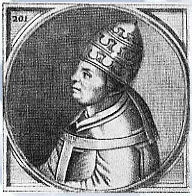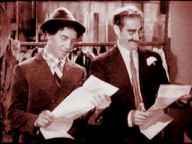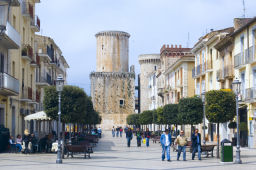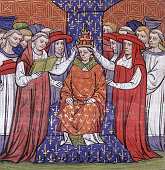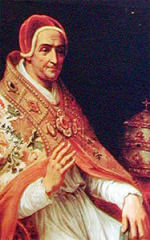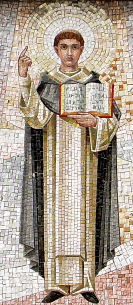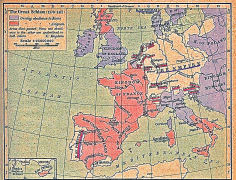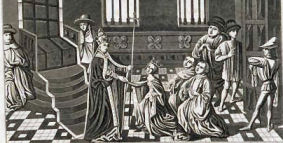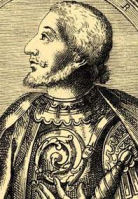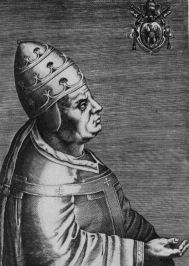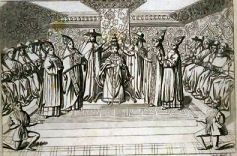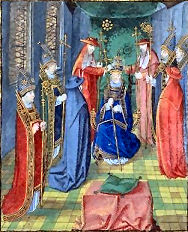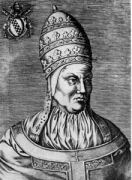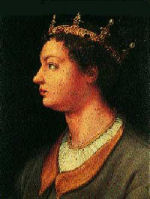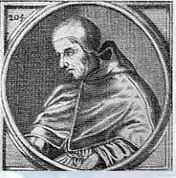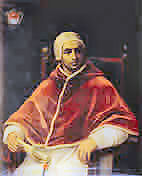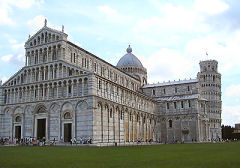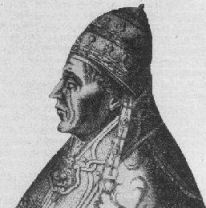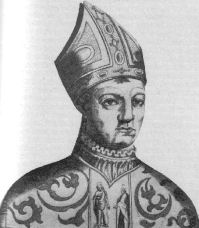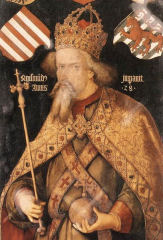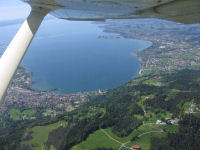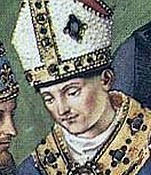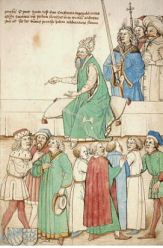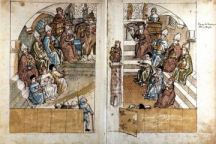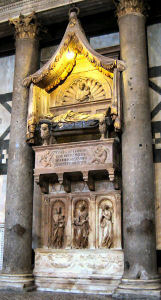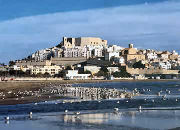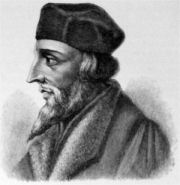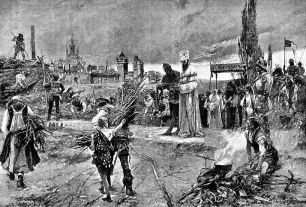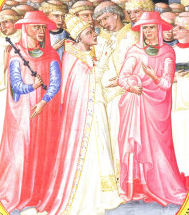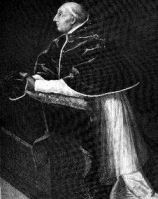Chapter 14: “Dici ‘Papato’; Je Dis ‘Papacy’.”
Back to Rome
In 1370 Clement VI’s nephew, Pierre Roger de Beaufort, became Pope Gregory XI. The star of his era and one of the most remarkable women ever, Catherine Benincasa, was only twenty-three at the time. Her twin who died at birth was her twenty-fourth sibling; twenty-two were older than she. Her father was a cloth-dyer in Siena. Her mother … Well, it is pretty obvious what her mother did. Catherine dedicated her virginity to the Lord at age seven and at sixteen joined the Dominican Tertiaries, who lived outside of convents. In her “Mystical Marriage” at age nineteen she claimed that Jesus put a ring on her finger, although like the stigmata that she later received, no one else could see it. Catherine of Siena[1] today is one of the patron saints of Italy. Nobody faults Catherine’s selfless devotion to the Christian ideal. She worked tirelessly for the poor and afflicted. In the 1370’s Catherine involved herself in ecclesiastic affairs. Her missives to leading clergy and heads of state never shied from criticizing reprobate behavior. The surviving letters demonstrate not only her good intentions but also her remarkable command of persuasive argumentation. Some of her targets ignored her, but many powerful people evidently took her seriously. The second half of the fourteenth century brought extreme violence to northern Italy. This was not simply one faction pitted against another. Many elements raged against the absentee papacy – Milan, Florence, and groups of freebooters such as those led by the Englishman John Hawkwood, whose loyalty shifted from side to side. The entire peninsula threatened to divorce itself from the Avignon papacy and elect its own pope. Pope Gregory dispatched ten thousand Breton mercenaries led by Cardinal Robert of Geneva to crush the rebellion. He then excommunicated everyone in Florence and put the city under interdict. In 1374 in the midst of the rebellion the plague broke out again and brought the continent to its knees for a year or so.In 1376 Florence employed Catherine – twenty-nine years old, a female, and a Sienese! – to plead its case to the pope. For two years Gregory XI had repeatedly proclaimed his intent to return to Rome, but time after time he postponed his departure. Catherine’s presentation may have persuaded him that the time was right. In any event he decided to move to Italy.
The cardinals were outraged, and they let him know it. They were not alone. “That last day, as Gregory quitted his Palace on the rock, the Pope’s mother stood in the doorway, tore open her robe to bear the breasts that had nursed him, and sobbed, ‘I shall never see you again!’”[2] Pope Gregory remained firm. On October 2, 1376, he tearfully weighed anchor from Marseilles. The journey was not easy; the pope’s contingent dealt with horrible weather, and hostile forces confronted them on the Italian shore. It took the pontiff until mid-January to claim the Holy See, and after only four months there he was forced to flee to Anagni.Meanwhile Cardinal Robert waged war with the rebels. The struggle culminated at Cesena, an inland location south of Ravenna. Hawkwood and his men were by then on the pontifical payroll. With the battle over and victory secure, the papal force disarmed the rebels and then killed four thousand or more civilians in the ill-starred town. “The cardinal thereupon ordered a general massacre. He hounded on his troops, crying out for Blood, Blood: ‘Kill them, kill them all!’ he shouted.”[3] In November Pope Gregory returned to Rome, but he achieved little before dying on March 27, 1378; Mère de Beaufort was right.
As the Romans Do
By law the College of Cardinals assembled at the site of the pope’s death. One of Pope Gregory’s last acts was to dictate rules for the upcoming conclave. He insisted that it be held immediately after his death. He ordered the cardinals in Italy not to wait for the six who had remained behind in Avignon. A two-thirds majority would suffice to elect the next pope. He even permitted the cardinals to move the conclave if necessary. French troops were garrisoned in Castel Sant’Angelo in anticipation of unrest.
Imagining “the Eternal City” of April 1378 is a challenge. The papacy, for centuries Rome’s defining feature, had been absent for three generations. A Roman born early in the fourteenth century could have lived a full life during which Rome’s bishop never set foot in the city! In the pope’s absence the populace had suffered through three waves of the Black Death. Could this be a coincidence? Rome’s population had dwindled to a minute fraction of its imperial maximum. By contrast, most cardinals had been living the high life in Avignon. Some could probably have bought and sold what was left of Rome. Of the sixteen timorous cardinals assembled in the Vatican ten (not counting Robert of Geneva) were French. Nevertheless, the Roman populace demanded that the next pope be a Roman or at least a simpatico Italian. Their meal ticket was back, and everyone was determined never to lose it again.As the conclave commenced, church bells sounded the call to arms. Tens of thousands of Romans – nearly the entire population of the decimated city – seized makeshift weaponry and surrounded the building hosting the election. Some rowdies apparently broke in. “The mob piled the room above the meeting-place with firewood and, from below, banged on the floorboards with pikes and halberds all through the night. … In the morning, the crowd lost patience altogether and broke down the conclave door.”[4]
The well-documented reaction of the terrified cardinals revealed their desperation. They resorted to the disgracefully lame trick of presenting the senile Roman cardinal outfitted in papal regalia. Many Romans dashed off to plunder the poor fellow’s house, a new twist on the time-honored custom of ransacking a dead pope’s dwelling. When the ruse was discovered, the cardinals quickly elected the Archbishop of Bari, Bartolomeo Prignano, a Neapolitan with years of experience as a bureaucratic functionary in Avignon. He managed the papal chancery for Pope Gregory XI. Although born and raised on the Italian peninsula, as a citizen of Naples he was a subject of Queen Joanna, the matriarch of the Anjou line and a long-time ally of the Avignon clergy.Prignano selected the name Urban VI. The cardinals may have expected him to move the papacy back to the civilized confines of Avignon. Perhaps they had just been buying time for a new election beyond the reach of the Roman mob. Cardinal Orsini reportedly informed Prignano that the cardinals expected him to turn down the office. Not bloody likely.
Pope Urban made it clear that his pontificate was permanently based in Rome. That proclamation diverted the wrath of the Romans from the pope to the cardinals. The mild-mannered bureaucrat shocked everyone with his scurrilous attacks upon the personal habits of the cardinals at whose side he had for decades patiently toiled. He exhibited an alarming tendency to fly from one mood to another at the drop of a zucchetto. The cardinals again tried the abdication trick once used on Pope Celestine V, but this time the mark was wise. Pope Urban really liked how the papal pallium felt on his shoulders. He loudly proclaimed that the pope could do anything whatever, and no one could stop him. Even the Italian cardinals came to consider him unhinged. What they really needed was Otis B. Driftwood’s Sanity Clause.
Twelve cardinals brought their entourages to Anagni and thence to Fondi, a little southeast of Rome. Within two months three of the four who remained with the pope joined their fellows. The one who remained behind in Rome was too ill to travel. On August 2, 1378, the cardinals in Fondi voted that the Vatican conclave had not been canonical because of the intimidating behavior of the Romans, declared the papacy vacant, and ordered Urban to cease using papal epithets.This turn of events upset Pope Urban. His secretary, Dietrich of Niem, reported that he often found the pontiff in tears. On September 18, however, the pope seized the bull by the horns and appointed twenty-eight new cardinals – almost twice the number that had abandoned him. Only four appointees refused the red hat.
The rebellious cardinals in Fondi quickly convened a conclave. In private conferences the Frenchmen had evidently tricked each Italian cardinal into believing that the French cardinals had all pledged to vote for him. The three Italian cardinals all abstained in the first scrutiny on September 20, but all the French voted for Cardinal Robert of Geneva, the thirty-six-year-old warrior-priest. He could claim with some merit to have been elected without dissent by the College of Cardinals. Robert took the name Clement VII. Was he the pope? The earlier election in Rome had clearly been conducted under extreme duress. Were conditions perilous enough to nullify the election? How would one judge? Historical precedents were almost useless. Dozens of popes had been selected by much less defensible processes. Several antipopes could claim a legal basis as strong as Clement’s. This case, however, had one distinction: with only one exception,[5] exactly the same cardinals who had elected Pope Urban, had voided their previous conclave and had, within a few months, chosen a new pope. Never before had the selfsame cardinals voluntarily rescinded their vote in favor of a new man. The situation must have confused ordinary Christians,[6] or it would have had they been allowed to think about it. In medieval Europe, any thinking that was required was left to the nobles and clergy. The rabble was expected to follow their lead, as sheep follow the shepherd. Confusion was absent in Rome, where Pope Urban unequivocally located his headquarters. His commitment to the city endeared him to its inhabitants. Pope Clement, on the other hand, had the stench of the French about him. That appellation “of Geneva” fooled no one. Moreover, who could forget that His Eminence had directed the massacre of all those Italians at Cesena?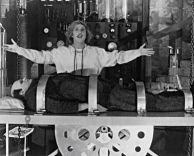
Pope Urban, the short, aged policy-wonk who always wore a hair shirt as a meek paper-shuffler in the Curia, morphed into a rabid tiger. Pope Clement, the vivacious stud who had cut such a dashing figure in his armor while clearing the pope’s path into Rome, became Mr. Peepers. Clement was the battle-scarred warrior, but it was Urban who rapidly mustered a formidable force headed by Count Alberico da Barbiano (A4?). Within months Urban’s army had driven Clement followers from Italy. The vanquished pope established his headquarters back in Avignon, where his cardinals gladly joined him. Urban’s troops then assaulted Castel Sant’Angelo. After a bloody battle, the French garrison stationed there was defeated. The two popes launched X-bombs toward one another, and the Great Western Schism began.
Two Popes for the Price of Two
By Medieval standards Clement turned out to be a laid-back and rather efficient pope. His cardinals remained loyal throughout his sixteen-year pontificate. They persuaded the King of France to lend his support, and through the intercession of Cardinal Pedro de Luna the “Avignon obedience” also received Spain’s backing. Eventually Scotland, Naples (i.e., southern Italy), Savoy, and hundreds of bishops throughout Europe aligned with Pope Clement. St. Vincent Ferrer was also a vocal supporter.I wonder if Sr. Mary Immaculata can explain how a saint could support an antipope. “Saints can make mistakes. Even St. Peter denied the Lord three times.”
Fiscal problems plagued the Avignon papacy. There were as many cardinals to feed, clothe, and entertain as before, but more than half of the erstwhile revenue stream was directed to Rome. Clement needed to devise more creative – and ruthless – approaches to generating income.
Pope Urban’s headquarters in Rome afforded natural advantages. He was soon endorsed by the emperor of Germany and by England, Scandinavia, Ireland, Hungary, Poland, and northern Italy. His saints included Catherine of Siena and Bridget, a Swedish native who resided in Rome.
Urban became obsessed with Naples. Initially Queen Joanna was overjoyed that one of her subjects wore the tiara, but Urban’s unseemly behavior appalled her. When she endorsed Pope Clement, Urban went postal. He persuaded Joanna’s adopted son and second cousin, Charles of Durazzo, to attempt a coup. Charles succeeded in this quest and then imprisoned his royal foster mother/cousin and had her strangled. As penance for this crime, the Holy Father imposed on Charles two Our Fathers, three Hail Marys, and the rule of the Kingdom of Naples.
The black sheep of the Prignano family was the pope’s nephew Francesco, generally known as Butillo (“chubby”). Pope Urban wanted a nice present for Butillo’s fortieth birthday bash. He had asked Charles to cede Salerno, Fondi, Caserta, Sorrento, Capua, and Amalfi to Butillo, but after Charles became king, he contracted amnesia concerning his arrangement with the pontiff. In fury His Holiness led his army toward Naples, but misadventures on the battlefield led to his entrapment in a castle in Nocera. Amid a rain of arrows he stood at his window with bell, book, and candle and excommunicated King Charles three or four times a day! After five months the pope finally slipped away and fled to Genoa. In 1385 Pope Urban apprehended, tortured, and eventually killed six cardinals – his own appointees. He had caught them discussing the legality of deposing a pope. Other clergy suspected of treason or other misdeeds were also tortured. Butillo oversaw most of the dirty work. “He caused the Cardinal Louis Donato to be interred in a bed of quicklime, leaving his head out of this infernal tomb, that he might feel his flesh all corrode and consume before his death. He shut up wolves in the dungeon of Bartholomew to devour him alive, and Gentil de Sangro and Martin del Guidice were sewed up in bags of leather, with serpents, and then cast into the sea.”[8] According to Cormenin, Butillo also flayed alive an archbishop, and the archbishop of Venice was nailed to a cross. Shortly after the cardinals were executed, the pontiff got wind of another conspiracy and abandoned Genoa for Perugia. There he declared a crusade against the Kingdom of Naples and Pope Clement, but he never even raised an army. His reputation for miserliness doomed his cause.The few attempts made during Pope Urban’s lifetime to reconcile the two papacies came to naught. Urban’s attention seldom strayed from King Charles and the disputed territories.
The pontiff’s sorties nearly bankrupted the Roman Church. To generate cash he adjusted the method of reckoning Jubilee Years so that 1390 qualified. Unfortunately he died in 1389. The official cause of death was that he fell off of his mule. No kidding. It is possible that someone slipped something into his cup while he was recuperating.
Urban VI was the last non-cardinal ever chosen as pope. The Roman cardinals, all of whom he had appointed, elected another Neapolitan, Piero Tomacelli, who took the name Boniface IX. Dietrich of Niem has reported that Boniface was illiterate. This was a minor handicap in an era of action, characterized by wars in southern Italy, not one but two Jubilee years (1396 and 1400), simony beyond anything ever witnessed in Rome, backbreaking taxes, and the customary nepotism. Pope Boniface authorized usury; he even loaned money at high rates of interest. The Roman pontiff succeeded in steadying his shaky hold over the Papal States; even Rome itself became less unruly for a time. In 1394 Pope Clement died in Avignon. A conclave there chose Pedro de Luna, the Spanish cardinal who had sixteen years earlier voted for both Urban VI and Clement VII. He took the name Benedict XIII. Four years later the French cardinals withdrew support. Pope Benedict withstood a five-year siege in Avignon before being forced to flee. He eventually ended up in Spain in the remote outpost of Peñiscola, where he lived until his death in 1423 at the age of ninety-five. For twenty-nine years he labored to convince Christendom of the legitimacy of his pontificate. His claim looks pretty good on paper, and, according to the imminent Church historian, Phillip Schaff, he “had the spirit and much of the ability of Hildebrand.” Nevertheless, in his last years the only people who still believed in him were the few who joined him in Peñiscola. Pope Boniface, in contrast, lived in Rome (or occasionally in the Umbrian towns of Perugia and Assisi) until his death in 1404. He was succeeded by the lawyer-cardinal, Cosimo de’ Migliorati. His papal name was Innocent VII. Before his election he fervently pledged to reunite the papacy. He promised to resign if Pope Benedict would do the same. However, the two short years of his pontificate dealt mostly with King Ladislas of Naples, who forbade the Roman pope from compromising with his rival. Pope Innocent made a cardinal of his nephew Ludovico. Ludovico was so upset at the locals’ disrespectful behavior towards his uncle that he hired thugs to kidnap eleven of their most prominent number. The hired muscle then brutally murdered their captives in the cardinal’s own residence, and flung their bodies out the window onto the street. The Roman mob drove both the cardinal and his uncle out of town. The pope settled in Viterbo until the situation calmed down. Meanwhile, King Ladislas’s troops occupied Castel Sant’Angelo. Pope Innocent died suddenly in 1406. Cardinal Baldassare Cossa, a major player in this increasingly complex intrigue, has long been suspected of his murder.[9]Angelo Correr, a Venetian who was pushing (or maybe even pulling) eighty at the time, was elected with the name Gregory XII. He swore to lay down his tiara if Pope Benedict were to do the same. Benedict agreed to negotiate the details in person. For months the two popes bickered over the location for the meeting. Cardinal Aretin from Lucca wrote to a colleague that “Gregory affirmed that all cities were equally agreeable to him, provided they were not situated on the sea shore. Benedict found them all to his taste, provided they were not in the interior.” Savona, a coastal town near Genoa, was finally selected as the site. The two pontiffs then performed an exchange worthy of Alphonse and Gaston over the conditions of the meeting. The prospect of Pope Gregory’s abdication dismayed his powerful relatives and associates in Venice. One again King Ladislas also actively subverted the process. Astral positioning was inauspicious. The meeting never happened.
Pope Gregory had four nephews. Having surveyed the list of his cardinals, he determined that the consistory could profit from four strong young voices. Guess whom he selected. In 1408 Pope Gregory got the bright idea of calling a council of his cardinals in Lucca to resolve the schism once and for all. This peculiar council operated under a cloud of threats emanating from the aged pope. Many cardinals, mindful of how Pope Urban had treated his “creatures,” feared for their lives. In direct contravention of papal orders, seven of them abandoned the council in order to negotiate with cardinals of the Avignon obedience. This mixed group convened in Pisa and invited both popes to join them. The new council enjoyed widespread approbation from the King of France, the prestigious universities of Oxford, Paris, and Cologne, and from most eminent scholars. However, neither pontiff appeared. Pope Gregory, in fact, defrocked the attending cardinals. The council called him “the coward, the drunkard, and the knave; the man of blood, the illustrious robber, the schismatic, the heretic, the precursor of antichrist.”One Pope Good; Two Popes Bad; Three Popes Ugly
In June of 1409 in the fifth session of the Council of Pisa, the Patriarch of Alexandria took the floor to denounce both popes as “schismatics, the approvers and makers of schism, notorious heretics, guilty of perjury and violation of solemn promises, and openly scandalizing the universal Church.” The claim about heresy was critical; if prevarication or being the subject of scandal were grounds for a pope’s dismissal, there might have been a thousand popes by now. Gregory’s most serious doctrinal transgression was consulting a Jewish doctor suspected of necromancy. As for Benedict, “it was testified that he had at his disposal two demons, whom he kept handy in a small purse. After his coronation he was said to have looked everywhere for books on magic, finally securing two in Spain and a third from the Muslims. To divine the future and to discover what people were saying about him, Benedict would place one of these volumes under his pillow before going to sleep.”[10]Both popes were deposed by the assembly of twenty-four cardinals, four patriarchs, ten archbishops, seventy-nine bishops (and representatives of another 116), 128 abbots and priors (and the representatives of another two hundred), the heads of the major orders, three hundred doctors of theology and canon law, 109 representatives of cathedral and collegiate chapters, and the deputies of nearly every important king and prince. The clergy joyfully intoned the Te Deum. The Great Western Schism had finally ended!
All that remained was to choose a new pope. Cardinal Cossa, the strongman of Bologna, persuaded the seventeen cardinals in conclave in Pisa to select the seventy-year-old Peter Filargi (also spelled Philargi or Philarghi), who called himself Alexander V. Alexander, who had close ties to the powerful Visconti family of Milan, was no stick in the mud; Peter De Rosa reported that his life was made more tolerable by a retinue of four hundred female servants whom he dolled up in his livery. “According to Dietrich van Niem, he was unfortunate in allowing his scandalous bestialities to be too publicly known. He also loved good cheer and rich wines, and was intoxicated regularly every night; so that his familiar friends allowed no one to approach him in his moments of reveling.”[11]As the council neared its end, the plague spread through Pisa. The Pisan pope fled to Pistoia. The majority of the clergy and the Christian rulers vociferously supported the newly elected pope. Almost everyone of note in European politics endorsed him as well. Was Alexander a real pope? To date the Church has issued no official opinion on this issue. Some semi-official lists have included him;[12] most today do not.
The schism continued; neither Pope Benedict nor Pope Gregory abdicated. Gregory was still rather firmly ensconced in Rome, and Benedict was under siege in Avignon. During the next ten months Pope Alexander made a determined effort to reach Rome, but he was thwarted by Pope Gregory’s champion, King Ladislas of Naples. Then Pope Alexander died suddenly in Bologna. Once again suspicion fell on Cardinal Cossa, in whose quarters the pope was staying.
The cardinals of the Pisan obedience gathered in Bologna to elect Alexander’s successor. Their host, Baldassare Cossa, “presented himself in the costume of a corsair, clad in a coat of mail, with a sword by his side, and took his place among the cardinals, threatening them with his displeasure, if they dared appoint a pope who was not agreeable to him.”[13] Three vetoes later, the hometown boy, Cossa, a cardinal-deacon but not a priest, was elected. After a few days of ceremonies he adopted the papal name of John XXIII.Cossa boasted a rather unusual résumé for a papabile. Born and raised in Naples, he had spent much of his youth on the high seas. Presumably he engaged in the family business of piracy; both of his brothers had been hung as pirates. The new pope exhibited a few noteworthy character flaws. De Rosa calls him a “mass-murderer, mass-fornicator with a partiality for nuns, adulterer on a scale unknown outside fables, simoniac par excellence, blackmailer, pimp, master of dirty tricks.” He stayed up all night and slept all day. He was sly, ruthless, and utterly devoid of scruples. Schaff called him “destitute of every moral virtue and capable of every vice.” In the fifteenth century this amalgam of traits made him pope material.
Pope John opened personal and Church accounts with the Medici bank in Florence. The stunningly beautiful baptistery adjoining the Duomo contains the crypt of only one man, the most notorious scoundrel who ever wore the tiara, Baldassare Cossa, the first Pope John XXIII.
The Council of Constance
Pope John mustered an army and fought his way into Rome. After beheading a few lords and magistrates suspected of supporting Pope Gregory, he proceeded to make peace with King Ladislas. Nevertheless, in June of 1413 Ladislas marched on Rome, drove Pope John back to his friends in Florence, and then sacked the city. Pope John called an audacious crusade against Ladislas. He offered the customary indulgences, but the response was minimal. A more innovative trick might have been expected from a pontiff with his reputation. The era’s politics were complicated. Sigismund, the King of the Hungarians who had claimed the title of emperor since 1410, pressured Pope John to convene a council to resolve the schism. The pontiff realized that his position was precarious, but he liked his hand well enough to play it out. The council that began on November 1, 1414, in the southern German lake town of Constance, was one of the most momentous events in Church history. The population of the town swelled from a mere six thousand souls to twenty times that number within four years. An estimated 1,200 prostitutes relieved stress among the assembled clergy and Church doctors. A survey also counted 346 buffoons, jugglers, and tumblers.Before departing for Constance, Pope John XXIII played his best card, the Ace of Bishops. Both Pisan popes had been very generous with their benefices. Italy was awash in miters, and under most of them were supporters of Pope John. The pope purchased Eurail Selectpasses for each bishop to ensure that most voters in attendance would be of the Pisan obedience. Unfortunately, Sigismund got to name trumps, and he selected countries, not bishops. Each “country” – France, Germany, England, Italy, and (later) Spain – received only one vote in the council.
Pope John soon sniffed a foul wind. Pamphlets enumerating a few dozen of his more degenerate vices circulated widely in Constance. He suddenly played his hole card, the Jack of Rabbits. On March 20, 1415, he snuck out of Constance in disguise and repaired to the dominions of Frederick of Hapsburg. He may have hoped that his absence would lead to the council’s disintegration. Emperor Sigismund, however, maintained order and put out an APB. In its famous fifth session the council declared that its authority was derived directly from Christ and that any General Council could act without the pope’s consent. Aeneas Sylvius Piccolomini, a future pope, wrote “Hardly anyone doubts that a council is above a pope.” The council declared Pope John’s flight a criminal act that rendered him suspect of heresy, a capital crime. Pope John tried to negotiate his surrender. He offered to turn in his tiara if he were allowed to remain a cardinal in control of both Italy and Avignon; he also demanded thirty thousand pieces of gold.“Uh, no.”
John XXIII hid out in Schaffhausen with a few loyal cardinals, but he was located and brought to judgment. It was the trial of the century. Witness after witness testified to the horrendously sinful conduct of the pope. Wylie describes the proceedings thus: “Public criers at the door of the church summoned John XXIII to appear and answer to the charges to be brought against him. The indictment contained seventy accusations, but only fifty were read in public Council. … Thirty-seven witnesses were examined, and one of the points to which they bore testimony, but which the Council left under a veil, was the poisoning of his predecessor, Alexander V. The charges were held to be proven.”[14]
The original charges, which reportedly included every sin known to man, were reduced to only five.[15] Many considered even this handful serious enough to merit the pyre. The council rapidly convicted Pope John on all five counts. His seals of office were smashed, and he was deposed. He played his last tattered card, the Deuce of Pity; he begged for mercy, and it worked. His sentence was only three years of imprisonment in Heidelberg. One might easily imagine him mumbling, “I can do that standing on one elbow.”On the fourth of July Pope Gregory, nearly ninety years old, capitulated through his intermediary, Charles of Malatesta. The bull presented by Malatesta also affirmed the council’s legitimacy. The council proclaimed that all cardinals of the Roman obedience were legitimate. Gregory remained a cardinal and retired to Ancona, where he died in October of 1417. For much of his pontificate there were three popes; during his last few months there was none.
Deposing Pope Benedict XIII was an exhausting task. The council members, remembering the failure of Pisa, insisted on dotting every i and crossing every t. Benedict refused to leave his remote location in Spain, and he never answered his e-mail. Exchanging communications was therefore very time-consuming. The emperor himself made the journey to Peñiscola to attempt to persuade him to abdicate, but Benedict insisted on choosing the next pope himself. He reasoned that all the other cardinals appointed before the schism were dead, so he alone was legitimate. This was not what anyone wanted to hear. Pope Benedict’s trial began in absentia in March of 1417, and he was deposed by the council on July 26 of the same year. Meanwhile, the attendees in Constance did more than just chuckle at the street performers and keep the working ladies in silk. A reported 264 corpses were retrieved from the lake.[16] Perhaps as many more were left for the fish. The participants also put the Bohemian intellectual, John Huss (or Jan Hus) on trial. Sigismund had granted Huss safe conduct, but when Huss arrived, the emperor had departed for Peñiscola. A kangaroo court associated with the council tried Huss for heresy. Dominican priests only vaguely familiar with his writings interrogated him. He was summarily convicted of heresy and, despite the emperor’s return, sentenced to death. A high hat festooned with dancing demons was placed on Huss’s head. A pyre was made of his books. Some say that as he walked into the fire he prayed for his persecutors. His ashes were scattered on the Rhine to prevent veneration as relics.Christianity needed a pope. It seemed time for a bold selection, someone to return the Church to the core values of the Sermon on the Mount, someone to wipe away the stain of decades of discord, corruption, nepotism, and venal politics. And yet, the man selected with little debate was Oddo Colonna,[17] who was no Hildebrand; “Old guard” was written all over his curriculum vitae. He was the patriarch of one of the families that had influenced Roman and papal politics for centuries. His father was Agapito Colonna, and his mother was Caterina Conti, descended from a nephew of Pope Innocent III. The Colonnas controlled Tusculum; Oddo was probably related to the families that produced the most infamous popes of the tenth and eleventh centuries. He was related to the man notorious for slapping Pope Boniface VIII as well as the two thieves who provoked the feud. Oddo had been appointed cardinal by Pope Boniface IX, but he joined the ranks of the Pisan obedience. He served as one of Pope John XXIII’s closest advisers, and he even supported the disgraced pontiff after his flight to Schaffhausen.
Everyone in the council, including the new pope, voted for the statements in the fifth session that General Councils derive their authority directly from Christ, not through the pope. Another provision mandated that the pope call a General Council in five years, then seven years later, and every ten years thereafter.Cardinal Colonna was elected Pope Martin V on November 11, 1417. Emperor Sigismund and Frederick of Brandenburg acted as strators in the elaborate ceremony. Pope Martin dissolved the council in May of 1418. He took his sweet time in returning to Rome, lingering in Florence where he met up with Baldassare Cossa, just released from prison with his new suit and $100. Finding a steady job is difficult for any ex-con, especially one with a rap sheet like Cossa’s. Over the course of the next few months the current and former popes spent pleasurable evenings swapping stories. Then the Holy Father thoughtfully set his former boss on the straight and narrow by naming him Bishop of Frascati and Cardinal of Tusculum. The convicted incestuous pirate, murderer, rapist, and sodomite thus smoothly rejoined the consistory. No one can claim that there is no second act in the Roman dramaturgy.
The Conciliar Movement
In September of 1420 – almost three years after his election – Pope Martin finally entered Rome. The situation was delicate. The Council of Constance had clearly asserted its authority over the pope; it had insisted that the pontiff curtail the papacy’s powers. Although he publicly supported the council’s decrees, he limited his endorsement to those passed conciliariter – in a conciliar way. Martin the pope had difficulty remembering what about these propositions seemed attractive to Oddo the cardinal. His papal bull “Frequens” declared the council ecumenical and binding with regard to faith and the salvation of souls. However, he circumvented some of its requirements by negotiating less restrictive concordats with each “nation.”
Was the council ecumenical? Did its rulings bind the pope? Were the popes required to call councils regularly? Martin acted as if he thought so, but his peculiar phrasing provided just enough wiggle room. Similarly, his successor, Pope Eugene IV, proclaimed that to the extent that the council’s decisions did not impinge on the law, dignity, and preeminence of the Apostolic See – which they did in abundance – they were valid. Eugene eventually accepted the acts of the Council of Basel, which specifically endorsed the fourth and fifth sessions of the Council of Constance. So, in theory the councils were powerful, but in practice …In 1423 Pope Martin dutifully called a council at Pavia, which was subsequently moved to Siena to avoid the plague. The assemblage was sparsely attended, and little of note transpired. It was the only council held during Martin’s thirteen-year pontificate. The agreements that he had made with the Council of Constance obligated him to convene a second council in the Swiss town of Basel in 1431, but he died before it began.

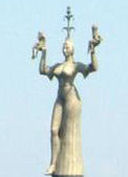
Needless to say, the period in which three men had strong claims to the papacy was not part of Sr. Mary Immaculata’s curriculum. It is easy to say in retrospect that the Roman popes were the legitimate ones; after all, the pope is the Bishop of Rome. Nevertheless, it is an uncomfortable fact that most Christians and most Christian leaders supported the two Pisan popes. Hardly anyone followed Pope Benedict XIII, but his legal argument was pretty strong, and of the three he was probably the most competent and saintly. It took a ruthless emperor to resolve the fiasco. I am not sure that the usual “mysterious ways” explanation would have sufficed.
[1] Her head and right thumb can be venerated in the church of St. Dominic in Siena. One of her feet is in Venice. The rest of her corpse is entombed in Rome.
[2] Marzieh Gail, The Three Popes, Simon and Schuster, New York, 1969, p. 20.
[3] Eustace J. Kitts, In the Days of the Councils: A Sketch of the Life and Times of Baldassare Cossa (Afterwards Pope John the Twenty-Third, Archibald Constable and Co. Ltd., London, 1908, p. 106.
[4] De Rosa, op. cit., p. 90.
[5] Cardinal Tebaldeschi, the aged Roman prelate who had been shown to the crowd as pope, had died in the interim.
[6] Feel free to draw your own conclusions. Urban is on the Vatican’s list, but no pope or council has ever ruled on whether he was a legitimate pope. The soul with the most at stake belongs to Charles of Durazzo, who was excommunicated and anathematized by Pope Urban hundreds of times.
[7] No, it didn’t, but no more sensible explanation for the subsequent conduct of the two popes has been posited.
[8] Cormenin, op. cit., p. 82.
[9] Martin, op. cit., p. 191.
[10] Gail, op. cit., p. 190. A college friend of mine practiced a similar technique for acing exams. He called it the “Vulcan Mind-Meld.” He opened a text book to a significant spot, placed the book on a chair next to his bed, positioned his glasses over the most important passage, and then confidently fell asleep.
[11] Cormenin, op. cit., Vol. II, p. 98.
[12] See, for example, Trollope, op. cit., pp. 127-128.
[13] Cormenin, op. cit., Vol. II, p. 100.
[14] James A. Wylie, The History of Protestantism, 1882, Vol. I, Book 3, p. 242.
[15] Gibbon related that he was charged with piracy, murder, rape, sodomy, and incest. At least the last one was no secret.
[16] Gail, op. cit., p. 225.
[17] Not to be confused with Odie Cologne, who faithfully served King Leonardo in Bongo Congo.
 | |
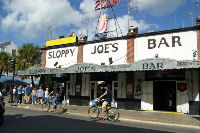 | |
Bankable Bar Bets
$ The cardinals in the conclave of 1378 were so terrified of the Roman people’s reaction that they pretended that they had elected a Roman cardinal as pope.
$ The Romans had a long-standing tradition of ransacking a pope’s house when he died. In 1378 they got a jump on the process by looting Cardinal Tebaldeschi’s home when he was presented as the new pope.
$ The cardinals in 1378 rescinded the election of Pope Urban VI and elected Cardinal Robert as Pope Clement VII.
$ In 1385, Pope Urban VI arrested, tortured, and eventually killed six of his own cardinals. He suspected them of plotting to overthrow him.
$ Pope Urban VI excommunicated Charles of Durazzo three or more times a day for five months.
$ The official cause of Pope Urban’s death was a fall from a mule. • Pedro de Luna (Benedict XIII) was the pope/antipope for twenty-nine years.
$ Pope Boniface IX was illiterate.
$ Pope Boniface IX’s pontificate featured two Jubilee celebrations – 1396 and 1400.
$ The Pisan Pope John XXIII was convicted by the Council of Constance of piracy, murder, rape, sodomy, and incest. He was sentenced to three years in prison. On his release Pope Martin V awarded him a bishopric, and he remained a cardinal.
$ During the Council of Constance 264 corpses were extracted from Lake Constance.
$ John Huss, a Bohemian theologian, was convicted of heresy by the Council. He was burned to death and his ashes were thrown into the river.
$ It took Pope Martin V two years and ten months to travel from Constance to Rome, a distance of 583 miles. He averaged a little over a mile a day.
